Students must practice this TS Intermediate Maths 2B Solutions Chapter 8 Differential Equations Ex 8(b) to find a better approach to solving the problems.
TS Inter 2nd Year Maths 2B Solutions Chapter 8 Differential Equations Ex 8(b)
I.
Question 1.
Find the general solution of \(\sqrt{1-x^2} d y+\sqrt{1-y^2} d x\) = 0.
Solution:
Given equation is \(\sqrt{1-x^2} d y+\sqrt{1-y^2} d x\) = 0
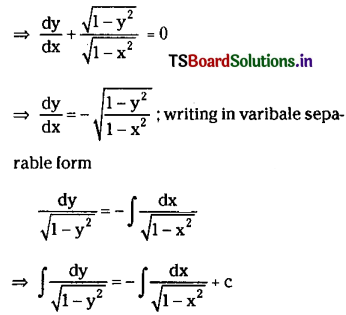
⇒ sin-1 y = – sin-1 x + c
⇒ sin-1 x + sin-1 y + c is the general solution.
![]()
Question 2.
Find the general solution of \(\frac{d y}{d x}=\frac{2 y}{x}\).
?Solution:
The given equation can be written in variable separable form as \(\frac{d y}{d x}=\frac{2 y}{x}\).
⇒ \(\frac{\mathrm{dy}}{\mathrm{y}}=2\left(\frac{\mathrm{dx}}{x}\right)\)
⇒ log |y| = 2 log |x| + log c1
⇒ log y = log x2 + log c
⇒ log \(\left(\frac{y}{x^2}\right)\) = log c
⇒ y = cx2
⇒ x2 = \(\frac{1}{c}\) y
⇒ x2 = c1y where c1 is a constant is the general solution.
II. Solve the following differential equations.
Question 1.
\(\frac{d y}{d x}=\frac{1+y^2}{1+x^2}\)
Solution:
The given equation can be written in variable seperable form as
\(\frac{d y}{d x}=\frac{1+y^2}{1+x^2}\)
∴ \(\int \frac{d y}{1+y^2}=\int \frac{d x}{1+x^2}\)
⇒ tan-1 y = tan-1 x + tan-1 c
⇒ tan-1 y = tan-1 x + tan-1 c is the solution of the given differential equation.
![]()
Question 2.
\(\frac{d y}{d x}\) = ey-x
Solution:
The given equation can be written in variable separable form as
\(\frac{d y}{d x}\) = ey-x
⇒ \(\frac{d y}{e^y}=\frac{d x}{e^x}\)
⇒ ∫ e-y dy = ∫ e-x dx
⇒ – e-y dy = – e-x + c
⇒ e-x – e-y = c is the solution 0f the given differential equation.
Question 3.
(ex + 1) y dy + (y + 1) dx = 0.
Solution:
The given differential equation can be written as (ex + 1)y dy = – (y + 1) dx
⇒ \(\frac{y d y}{y+1}=-\frac{d x}{e^x+1}\)
⇒ \(\left[\frac{(y+1)-1}{y+1}\right] d y=\frac{-e^{-x}}{1+e^{-x}} d x\)
∴ ∫ dy – ∫ \(\frac{d y}{y+1}\) dx = ∫ \(\frac{\mathrm{e}^{-\mathrm{x}}}{1+\mathrm{e}^{-\mathrm{x}}}\) dx
⇒ y – log (y + 1) = log (1 + e-x)
⇒ y = log (y + 1) + log (1 + e-x) + log c
= log [(y + 1) (e-x + 1) c]
∴ ey = c(y + 1) (e-x + 1)
∴ The solution of the given equation is
ey = c (y + 1) (1 + e-x).
![]()
Question 4.
\(\frac{d y}{d x}\) = ex-y + x2e-y
Solution:
\(\frac{d y}{d x}\) = ex-y + x2e-y
= e-y (ex + x2)
Writing in variable separable form we get
\(\frac{d y}{d x}\) = \(\frac{1}{y}\) (ex + x2)
⇒ ∫ ey dy = ∫ (ex + x2) dx
⇒ ey = ex + \(\frac{x^3}{3}\) + c
The solution of the given equation is ey = ex + \(\frac{x^3}{3}\) + c.
Question 5.
tan y dx + tan x dy = 0.
Solution:
The given equation can be written as
\(\frac{d x}{\tan x}+\frac{d y}{\tan y}\) = 0
⇒ \(\int \frac{\mathrm{dx}}{\tan x}+\int \frac{\mathrm{dy}}{\tan y}\) = 0
⇒ ∫ cot x dx + ∫ cot y dy = 0
⇒ log (sin x) + log (sin y) = log c
⇒ sin x sin y = c is the solution of the given differential equation.
Question 6.
\(\sqrt{1+x^2} d x+\sqrt{1+y^2} d y\) = 0
Solution:
The given equation can be written in variable seperable form as
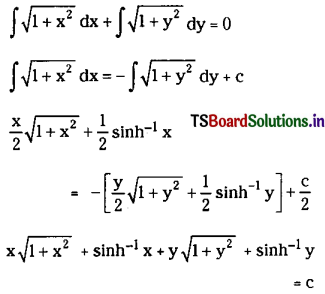
![]()
Question 7.
y – x\(\frac{d y}{d x}\) = 5 (y2 + \(\frac{d y}{d x}\))
Solution:
The given differential equation is
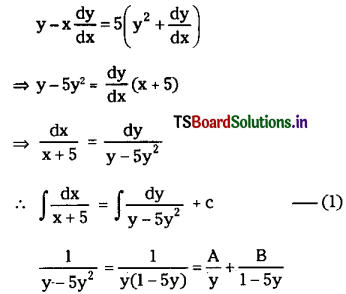
∴ 1 = A (1 – 5y) + By
⇒ A = 1 and B – 5A = 0
⇒ B = 5
∴ \(\int \frac{1}{y-5 y^2} d y=\int \frac{1}{y} d y+\int \frac{5}{1-5 y} d y\)
= log |y| – log (1 – 5y)
∴ From (1)
log |x + 5| = log |y| – log (1 – 5y) + log c
⇒ x + 5 = \(\frac{c y}{1-5 y}\)
∴ Solution of the given dillerential equation is 5 + x = \(\frac{c y}{1-5 y}\)
Question 8.
\(\frac{d y}{d x}=\frac{y(x+1)}{x(y+1)}\)
Solution:
The given equation \(\frac{d y}{d x}=\frac{y(x+1)}{x(y+1)}\) writing in variable separable form
\(\frac{(y+1) d y}{y}=\frac{(x+1) d x}{x}\)
\(\int\left(\frac{y+1}{y}\right) d y=\int \frac{(x+1) d x}{x}\)
⇒ y + log |y| = x + log |x| + log c
⇒ y – x = |og |x| – log |y| + log c
= log \(\left(\frac{c x}{y}\right)\)
∴ y – x = log \(\left(\frac{c x}{y}\right)\) is the solution.
![]()
III. Solve the following differential equations.
Question 1.
\(\frac{d y}{d x}=\frac{1+y^2}{\left(1+x^2\right) x y}\)
Solution:
The given equation is \(\frac{d y}{d x}=\frac{1+y^2}{\left(1+x^2\right) x y}\) which can be written in variable separable form as
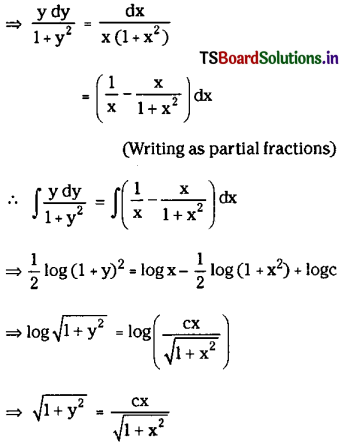
⇒ (1 + x2) (1 + y2) = c2x2
= cx2 where c2 = c is a constant
∴ The solution of the given differential equation is
(1 + x2) (1 + y2) = cx2
Question 2.
\(\frac{d y}{d x}\) + x2 = x2 e3y
Solution:
The given equation can be written in variable separable form as
\(\frac{d y}{d x}\) = x2 e3y – x2
= x2 (e3y – 1)
\(\frac{d y}{e^{3 y}-1}\) = xsup>2 dx
∴ ∫ \(\frac{d y}{e^{3 y}-1}\) = ∫ x2 dx
⇒ ∫ \(\left(\frac{e^{-3 y}}{1-e^{-3 y}}\right)\) dy = \(\frac{x^3}{3}\) + c
⇒ log (1 – e-3y) = x3 + c
⇒ 1 – e-3y = ex3 + ec
= k ex3
∴ The solution of the given differential equation is 1 – e-3y = k ex3.
![]()
Question 3.
(xy2 + x) dx + (yx2 + y) dy = 0
Solution:
The given dilferential equation can be written as
x (y2 + 1) dx + y(x2 + 1) dy = 0 which can be expressed in variable separable form as
\(\frac{1}{2} \int \frac{2 x d x}{x^2+1}+\frac{1}{2} \int \frac{2 y d y}{y^2+1}\) = 0
⇒ \(\frac{1}{2}\) log(x2 + 1) + log (y2 + 1) = log c
⇒ log \(\sqrt{\mathrm{x}^2+1}\) + log \(\sqrt{\mathrm{y}^2+1}\) = log c
⇒ (1 + x2) (1 + y2) = c2.
Question 4.
\(\frac{d y}{d x}\) = 2y tanh x
Solution:
The given equation is \(\frac{d y}{d x}\) = 2y tanh x.
\(\frac{d y}{y}\) = 2 tanh x (variable separable form)
∫ \(\frac{d y}{y}\) = 2 ∫ tanh x dx
⇒ log y = 2 log |cosh x| + log c
= log |cosh2 x| + log c
log y = log (c cosh2 x)
y = c .cosh2 x which is the solution of the given differential equation.
Question 5.
Sin-1 (\(\frac{d y}{d x}\)) = x + y
Solution:
The given equation is Sin-1 (\(\frac{d y}{d x}\)) = x + y
⇒ sin (x + y) = \(\frac{d y}{d x}\) …………..(1)
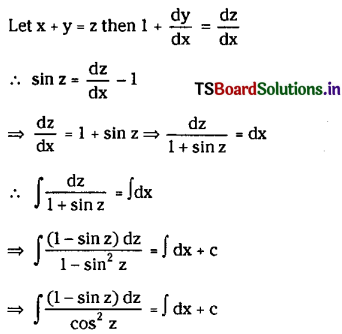
⇒ ∫ sec2 dz – ∫ sec z tan x dx = ∫ dx + c
⇒ tan z – sec z = x + c
⇒ tan (x + y) – sec (x + y) = x + c is the solution of the given differential equation.
![]()
Question 6.
\(\frac{d y}{d x}+\frac{y^2+y+1}{x^2+x+1}\) = 0
Solution:
Given equation in variable separable form is
\(\frac{d y}{y^2+y+1}=-\frac{d x}{x^2+x+1}\)
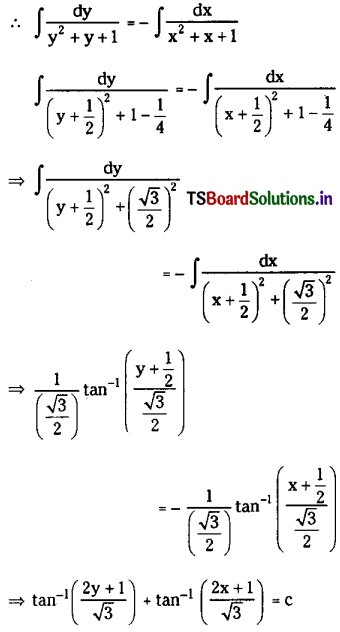
Question 7.
\(\frac{d y}{d x}\) = tan2 (x + y)
Solution:
Let x + y = z then 1 + \(\frac{d y}{d x}\) = \(\frac{d z}{d x}\)
from the given equation
∴ 1 + \(\frac{d y}{d x}\) = 1 + tan2 (x + y)
⇒ \(\frac{d z}{d x}\) = sec2 z
⇒ ∫ \(\frac{\mathrm{d} z}{\sec ^2 z}\) = ∫ dx + c
⇒ ∫ cos2 z dz = x + c
⇒ ∫ \(\left(\frac{1+\cos 2 z}{2}\right)\) dz = x + c
⇒ \(\frac{1}{2}\) z + \(\frac{1}{4}\) sin 2z = x + c
⇒ 2z + sin 2z = 4x + 4c
⇒ 2 (x + y) + sin 2 (x + y) = 4x + 4c
⇒ sin 2 (x + y) = 2x – 2y + 4c
= 2x – 2y + c1
where c1 = 4c.